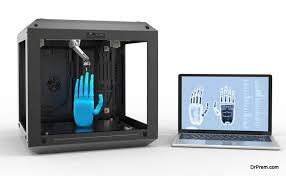PROSTHESIS
A prosthesis in an artificial body part that replaces a part that’s missing or no longer functional. You might use a prosthesis if you’ve lost a body part due to injury or disease, or you were born without one, A prosthesis can be an external part that you wear during the day and remove at night like a prosthetic limb. There are many types of prosthetic devices to help people regain mobility. They fall into four main categories; transradial, transhumeral, transtibial, and transfemoral. Each serves a different function depending on what body part is missing
How prosthesis is used
- Prosthesis can be used to improve appearance
- Prosthesis can be used to replace a missing body part.
- Prosthesis can used to replace a body part that was lost due to some trauma.
- Prosthesis can be used as an alternative to reconstructive surgery.
- Best Artificial Limb Near Me | Protheses & Orthoses 9321110091
BACK UP LIMBS 3D PRINTED PROSTHESIS:
3D-printed prostheses are revolutionizing the field of assistive technology by making prosthetic limbs more affordable, customizable, and accessible. These prosthetics are created using 3D printing technology, which allows for rapid prototyping and production at a fraction of the cost of traditional prosthetics.
Advantages of 3D-Printed Prosthesis:
- Affordability: 3D printing prostheses are in budget as compared with the traditional prostheses.
- Customization: They can be tailored to fit an individual’s specific needs, ensuring comfort and functionality.
- Rapid Production: A 3D-printed prosthetic limb can be created in a few days, compared to weeks or months for traditional ones.
- Lightweight & Durable: Made from strong, lightweight and advanced composites.
Types of 3D-Printed Prosthesis:
- Upper Limb Prostheses: Hands, fingers, forearms with functional grips or myoelectric control.
- Lower Limb Prostheses: Feet, legs, or joints designed for stability and movement.
- Partial Prosthetics: Custom-fitted solutions for missing digits or smaller body parts.



Types of Prosthetic Limbs
-
Upper Limb Prostheses
- Prosthetic Hand – Can be cosmetic or functional (e.g., robotic hands with grasping ability).
- Prosthetic Arm – Includes elbow and wrist functions in advanced models.
- Myoelectric Arm – Uses electrical signals from muscles to control movement.
-
Lower Limb Prostheses
- Prosthetic Foot – Designed for walking, running, or even sports activities.
- Prosthetic Leg – Includes knee joints and shock-absorbing mechanisms for smooth movement.
- Bionic Legs – Advanced versions with microprocessors for better movement and balance.
Key Features of advanced Prosthesis
- Lightweight Materials – Carbon fiber, titanium, and advanced plastics for durability and comfort.
- Custom Fit – Made using 3D scanning and printing for a perfect fit.
- Bionic & Smart Prosthetics – Use AI and sensors to mimic natural movement.
- Myoelectric & Neural-Controlled Prosthetics – Enable more natural and intuitive control using nerve signals.
Why Choose Prosthesis
Prosthetics play a crucial role in restoring mobility, confidence, and independence for individuals who have lost a limb due to injury, illness, or congenital conditions. Modern advancements in prosthetic technology have made artificial limbs more functional, comfortable, and lifelike than ever before. Here’s why choosing prosthetics can be a life-changing decision:
Choosing prosthetics is a powerful step towards reclaiming an active and independent life. With the right prosthetic solution, individuals can overcome physical limitations and embrace new opportunities with confidence and determination. If you or a loved one is considering prosthetics, consult with a specialist to explore the best options tailored to your needs.



How Prostheses Improve Quality of Life
Prosthetics play a vital role in restoring independence and enhancing the overall well-being of individuals who have lost a limb due to injury, illness, or congenital conditions. Thanks to advancements in technology, modern prosthetics offer improved functionality, comfort, and aesthetics, helping users lead active and fulfilling lives. Here’s how prosthetics improve quality of life:
1. Restoring Mobility and Independence
One of the biggest advantages of prosthetics is that they help individuals regain their ability to move freely. Whether it’s a prosthetic leg for walking or a prosthetic arm for daily tasks, these devices enable users to perform everyday activities with confidence.
2. Enhancing Physical Health
Prolonged immobility can lead to muscle atrophy, joint stiffness, and circulation problems. Prosthetics help users stay active, reducing the risk of secondary health issues and promoting overall physical fitness.
3. Boosting Self-Confidence
Losing a limb can impact a person’s self-esteem, but a well-fitted prosthetic can restore confidence. Many users find that prosthetics help them feel more comfortable in social and professional settings, improving their emotional well-being.
4. Enabling Participation in Sports and Activities
Specialized prosthetics allow individuals to engage in sports and recreational activities, from running and cycling to swimming and rock climbing. These adaptive prosthetics empower users to pursue their passions and maintain an active lifestyle.
Carbon Fiber Prostheses
Advantages of Carbon Fiber Prostheses
- Lightweight – Carbon fiber is much lighter than traditional materials like metal, reducing strain and fatigue.
- Durability – The material is resistant to wear, corrosion, and impact, making it long-lasting.
- Energy Efficiency – Carbon fiber prostheses store and release energy efficiently, helping users walk or run with a more natural gait.
- Customizability – Advanced manufacturing allows for tailor-made prosthetic limbs suited to individual needs.
- Aesthetic Appeal – Many users appreciate the sleek, modern look of carbon fiber prosthetics.
Types of Carbon Fiber Prostheses
- Lower Limb Prostheses – Common in both everyday users and athletes, featuring dynamic footplates and shock-absorbing pylons.
- Upper Limb Prostheses – Less common but still used for lightweight and strong artificial arms or hands.
- Sports-Specific Prostheses – Used in running, cycling, and even extreme sports, offering specialized designs for optimal performance.
Prosthetic Fittings and Adjustments What to Expect
Getting a prosthetic limb is a life-changing experience, but it requires a proper fitting and ongoing adjustments to ensure comfort and functionality. The process involves multiple steps, from initial assessments to final customization, ensuring that the prosthetic meets the user’s unique needs.
The journey begins with a consultation with a prosthetist, a specialist who evaluates the residual limb, overall health, and lifestyle requirements. This assessment helps determine the most suitable type of prosthetic, whether for daily use, sports, or specific activities. Once the right prosthetic is chosen, a custom socket is created to fit securely and comfortably. The socket is the part of the prosthetic that connects to the residual limb, and achieving the perfect fit is crucial to preventing discomfort, skin irritation, or pressure sores.









